
“Through the hamlet of Cornwood they drove, past a graceful cross that lifted beneath an oak; and then onward by hill and dale and farmstead, by water-meadows and streamlets, through woods and pastures, their road extended – so lonely that it was grass-grown in places. The lanes – survivals of old pack-horse tracks – had burrowed deeply into the hills, and often adjacent lands were far higher than the road, Deep set in green lay their route, under hedges of hazel and polled oak, while the sides of it glistened with the green ferns and sparkled with many flowers.”
Eden Phillpotts, 1915, Brunels Tower, p. 272.
Although written over one hundred years ago these words can still describe the journey from Cornwood up to the tiny hamlet of Harford today. Admitted you will not come across trains of packhorses clopping down the road anymore but and as on the day of my visit I merely encountered a tractor and slurry tanker trundling laboriously up the hill. It was a good few years since I last visited Harford and then it was just a brief call to the churchyard to get a photo of the venerable old cross and away again. This time I would “stop and stare” a while and take in the rustic charm of this tiny moorland hamlet and its church.
A cursory glance at any OS map will soon reveal that Harford is virtually surrounded by prehistoric settlements, hut circles and ritual monuments and thus indicating human settlement long before any historic documentation appeared. The first documentary evidence of Harford appears in the Domesday Book of 1086 as Hereford when the Lord of the Manor was Reginald of Vautortes with Count Robert of Mortain being the Tenant in Chief. At that time there were 14 households consisting of 6 villagers, 6 smallholders and 2 slaves Between them they owned 5 cattle, 5 pigs, 20 sheep and 11 goats. The resources of the manor was assessed as comprising of 5 ploughlands, 1 Lord’s plough team, 2 men’s plough teams, 0.5 Lord’s pasture and pasture of 1, 0.5 leagues. The manor was valued at 1 pound 10 shillings for Reginald and 3 pounds for Robert.
“And did those feet in ancient times walk upon England’s mountains green.” – The English Place-Name Society suggest that the name Hereford derives from two old Anglo Saxon words – here meaning army and ford a crossing over the river Erme. This could suggest a very early crossing place of the river Erme once upon an old military path. A century or so later there is no question that an old monastic way passed through Harford as it went from the Augustinian priory at Plympton on its way to Cistercian abbey at Buckfast. The route would have been from Plympton up past Sparkwell, through Lutton and Cornwood onto Harford. From the moorgate at Harford it travelled onto the open moor as it made its way to Spurrell’s Cross and leaving the moor at Owley Gate. From there crossed the river Avon, skirted around Brent Hill onto Harbourneford and finally through Buckfastleigh and finishing at Buckfast Abbey.
Closely connected with the old monks path is an ancient stone cross which stands at the entrance to Harford churchyard and a possible fragment of another lying just to the side of the porch. The intact cross, like many of Dartmoor’s other ancient crosses was discovered in the 1909 serving as a gatepost. In order to be fashioned into a gatepost the arms were broken off which is why the cross appears so odd today. On the other hand Harry Satrkey considered that this was not the case and the form we see today was intentional. – Dartmoor Crosses, 1989, p.58. In the Harford records the then rector J. A. Urban wrote; “The old cross. This day (the King’s birthday 9th November 1909) has been set up at the south-western corner of the churchyard, an ancient cross, which I recently discovered, desecrated to do duty as a gate-post, at the lower end of the sanctuary glebe lands. Long may it stand, a silent witness to the passer-by, of the faith of ages. It was a post for the third gateway on the right going up Harford Lane (see map below).” – Heritage Gateway (online source). Harry Starkey was of the opinion that inside the moor gate; ” are the remains of a hedge bank and other signs which indicate that in former days a stroll between the enclosures would have followed the now existing hedges and brought the stroll out onto the open moor a couple of hundred yards south of the present moor gate. If the proposition be accepted that this stroll was the route by which the ancient track came to join the lane near the church, then the junction of the stroll with the lane would be the natural place for a waymark to be sited.” – p.58. The age of the cross has been dated as medieval – between 1066 AD and 1539 AD. The dimensions of the cross are 1.36 metres tall with an amputated span of 38 centimetres along with a shaft circumference of 1.03 metres. As far as I can discern the first author to mention this cross was Masson Phillips in 1937, certainly William Crossing makes no mention of it despite lending a few words to the church.
The second fragment of an ancient cross is more of an enigma as to where it came from. Stone crosses were placed along the routes of the Dartmoor monastic tracks to serve as way-markers and also as possible reminder of God’s presence. So, taking the known crosses on the route, from the Harford cross the next in line when entering the open moor would have been Spurrell’s Cross and then nothing between there and leaving the moor at Owley Gate. Maybe this onetime cross was at Owley Gate then there would have been one on entering the moor and another leaving the moor?
Just opposite the church in the wall of Harford Ash Farm is a small granite trough which is fed from a pipe in the farm yard. This would have provided a welcome drink of water for anyone or any animals coming either up the hill or off of the open moor. The other enigma which stands on the western side of the churchyard is a tall menhir-like granite pillar. At some point in history it clearly has been used as a gatepost as proven by the metal latch and ring. There is also a shallow hole which has been drilled into its face. As to the reason for it being put in the churchyard is anybodies guess? Perhaps it served as a gatepost into an old side entrance to the church? Maybe even at sometime deep in the realms of pre-history it was indeed a standing stone? One thing for sure it was put there for some reason.
HARFORD CHURCH.
“The church itself, on the edge of the granite, stands on different ground; open enough to “winter and rough weather,” but above the deep mire of the lower country. There is no village around it. The grey lichen-stained tower lifts itself in solitude among wind-swept beeches and sycamores on a knoll at the entrance of a hollow combe passing upwards towards the moors… The voice of the river and the rustle of the breeze through the sycamores will perhaps be the only sounds to greet the ear of a wanderer as he reached the little churchyard of Harford. He will then find that he must journey to the vicarage, which is no great distance, for the key, of portentous size and weight, which is to admit him within the walls; and, when he has at last made good his entry, he may possibly think that, however picturesque as a point in the landscape the church itself is of little interest. But let him not be too hasty in his judgment. The simple perpendicular church, built of solid granite, with tracery broken from its windows, and its interior filled with pews whose irregular outline is at least picturesque, has in itself one or two points worth notice. The roofs, time-worn and shattered as they are, show that skill in wood-work for which ancient Devonshire was so remarkable was by no means beyond the reach of the old builders at Harford. Every rib of the cradle-roof in the nave is carved with a twining stem, from which graceful leafage expands on either side; whilst the stem itself branches from the wall-plate, also carved, and decorated.” – The Saturday Review.
On this visit there was not a soul around, it was a balmy June day, the soundscape was tranquil to say the least with the birds warbling in the trees, the distance sound of sheep bleating and the raucous clucking of the farm fowl, all accompanied by the gentle gurgle from the opposite well. Passing through the creaky lych gate with its moss and lichen covered roof one is confronted by a dappled granite edifice fronted by a huge yew tree, both guarded by regimental ranks of ancient graves. Not normally of a poetical bent I could not help thinking of Thomas Gray’s lines – “Beneath those rugged elms, that yew-tree’s shade, Where heaves the turf in many a mould’ring heap, Each in his narrow cell for ever laid, The rude forefathers of the hamlet sleep.” Passing through the unassuming porch the heavy wooden door appears and on entering one is greeted by a light and airy interior. What a delightful surprise, first thoughts being – “how come such a small hamlet should have such a gem of a church?” Sadly there was a stark reminder of the present day just inside – the obligatory container of hand sanitiser but leaving that aside one gets transported to a timeless age of both celebrations and melancholy. Over the centuries numerous authors have written different opinions of the little church. Some describe it as being of “little interest” whilst others rave about it. Amazingly in John Pegg’s 1986 book – ‘Discover the Churches of Dartmoor’ Harford is not even included?
It has been suggested that the early Christians of the Saxon era first worshipped on the site with the first rector being instituted in 1262. The main building is said to date back to the 1500s and most likely earlier. A dateable fact to this theory being that two early church bells were cast in Exeter around 1400. In 1555 the church was dedicated to St. George the Martyr but then sometime in the 18th century was re-dedicated to St. Petroc. This is one of three Dartmoor churches dedicated to the saint, the others being nearby South Brent and Lydford. Incidentally the Devon flag is also dedicated to St. Petroc. Harford Church also has the accolade of sitting at the third highest altitude of all churches on the southern moor.
As with many rural churches their fortunes blossomed and waned over the centuries and Harford was no exception. In 1859 William Cotton from Ivybridge described the building as being; “in a very bad state of disrepair, with green mould struggling everywhere against sickly white wash.” – Devon & Dartmoor HER, MDV2856 (ONLINE SOURCE). In the July of 1875 C. Worthy made a visit to the church and described it as; “comprised a chancel; nave separated from a south aisle by an arcade of four bays supported upon slender, perpendicular columns; north transept; south porch (badly repaired; square-headed arch); low square tower at west end containing 3 bells. Tower staircase carried up in thickness of its north wall. Fine trefoiled piscina on south side of altar, and a good example of a Hagioscope or Squint from the east end of the aisle into the chancel.
The windows generally had very debased arches, and absence of tracery, save in the east and west ends of the structure, which had been neatly restored. The Priests’ Door opened into the aisle, at the east end of which a bracket, which had once supported an image, still remained. Many good bosses of foliage existed in fair preservation, and every rib of the cradle roof was carried into a twining leaf or stem. As aspersorium (holy water basin) on east side of the interior south door. West entrance blocked up. At the time of his visit, repairs had been going on some time.” – Devon & Dartmoor HER, MDV2856 (ONLINE SOURCE). He also made mention of various pieces of communion silver dating from between 1687 and 1782.
In 1875 a restoration programme began with the roof being reslated and the porch which was in total disrepair rebuilt. Following that the north vestry and the organ chamber were added. Then in 1878 the restoration project was dramatically ramped up which took a year to complete. On the 28th of January 1879 the Bishop of Exeter reopened the church after a year’s restoration programme. The Western Morning News at the time reported that; “The work was placed in the hands of Mr. H. Elliott, architect, of Plymouth, and the church was closed for the purposes of restoration in July last. The transformation is now complete, and one would scarcely recognise the dull uncomfortable little church of the early part of last year in the handsome place of worship which yesterday opened. The old high-box pews of former years have been removed, and new seats of pitch-pine substituted. The whole of the floor of the church has been excavated and covered with concrete, and the aisles, &c., laid with tiles. The whitewashed walls have been scraped and re plastered, and the timbers of the internal portions of the roof – some of which were very rotten – have also been renewed. The tower has been extensively repaired, and many minor details have received attention, besides which a very complete heating system has been supplied. The total cost will probably be about £800. The efforts of Mr. Elliot to render the restoration as complete as possible received warm appreciation from all concerned, and the contractors Messrs. Cornish and Dyer, Ivybridge – also received their due share of the praise. The church will seat 200 persons, and although the nearest churches are at Ivybridge and Cornwood, the district is so thinly populated that the accommodation will be ample… The Bishop afterwards consecrated an addition of about a perch of land to the burial ground immediately in front of the church, given by Mr. J. J. MacAndrew.” – Wednesday, January 29th, 1879.
In the June of 1879 rumours abounded that in addition to the previous work there were also plans to plaster the exterior of the church tower. One disgruntled correspondent to the Western Morning News strongly complained that; “This tower is the most interesting part of the building – it has stood for centuries as left by its original builders – and surely the atmosphere is no damper now that it has been for ages past. Why, therefore, deface and conceal with stucco what was intended to be exposed. I trust that the rumour is incorrect, and that it is only intended to rake out and repoint the points of the masonry.” – Tuesday, 24th June, 1879.
Between 1920 and 1921 the stained glass window in the east window of the chancel was installed. It was in memory of J. J. MacAndrew and was made by Messrs. Powell & Sons of London. Around about the same time the old pitch pine pulpit and stalls were sold to to a needy parish somewhere in Wales these would have been the ones installed in the 1878 restoration works.. This allowed the installation of new oak furniture carved by Violet Pinwell of Plymouth. Another stained glass window was installed in 1931 in the east window of the south aisle in memory of Reverend C. R. Patey. The church underwent further restoration to its interior in 1969 and in 1977-8 it was reported that the building was in good state of repair despite damp and water seepage in the tower and the tracery to three light windows had work done on their tracery. – Devon & Dartmoor HER, MDV2856 (ONLINE SOURCE). So this brief history illustrates the various changes the church has undergone in order to be what is seen today. If you would like a full architectural description of the building then visit the British Listed Buildings website – HERE.
Having looked at the structure what about its ‘treasures’ ? There is one that really stands out and is the tomb chest of Thomas Williams which rests sedately in the chancel. He was born at nearby Stowford. During his lifetime he became a lawyer and a member of the Inner Temple, a member of Parliament for Bodmin, Saltash, Tavistock and Exeter and in 1563 became the Speaker of the House of Commons. On the lid of his tomb is a splendid brass image of him in knightly armour, the family crest and a plaque which reads – “Here lyeth the corps of Thoms Willms esquire – Twice reader he in court was – Whose sacred minde to vertu did aspire – Of Parlament he speaker hence did passé – The comen he studied to preserue – And thew relygion ever to maynetayne – In place of justyce where as he dyd serue – And nowe in heaven wth mightie love doth raigne – Obiit primo die mensis Julii Ao Dni Moccccclxvi (he died on the first day of July 1556) . – Aetatis suæ anno quinquagesimo secundo (in the fiftieth second year of his life).”
Another son of Stowford commemorated in the church is John Prideaux. Although not as opulent as Williams’ tomb his wooden memorial plaque sits on the southern wall. It reads; “Here rest the bodies of John Prideavx – of Stowford and Agnes his only wife, the – Parents of (7) sonnes and (3) davghters – whom – John Prideavx their 4th sonne Doctor of – Divinity and the Kings Majesties Professor – thereof in the Vniversity of Oxford. – Rector of Exceter College and Chaplaine – To Prince Henry, King James the – First and King Charles the First, – Hath left this filiall – remembrance. – 1693.” Initial thoughts on this plaque must be what excellent condition it’s in for its age and the explanation is that to mark the Queen’s Golden Jubilee in 2012 the Harford PCC paid for its cleaning and restoration.
“The bells, the bells.” – just beside the tower are two old bells and their clappers. According to an inventory for Edward VI in 1552 there were three bells. One of the bells is treble bell possibly cast at Exeter in 1400 and carries the unknown inscription “NOTEORIA” There was another cast around the same time and carries the inscription “INNOMINE PATRIS” (In the name of the Father). In 1963 this bell was donated to St. Paul’s Church at Efford. The third bell which the Devon & Dartmoor HER states is a tenor bell that was cast in 1686 by Mordecai Cockey in Totnes. This inscription reads “Thomas Williams Esquire Churchwarden 1686. Mordecai cast me in Totnes,” and is rung for services. Slightly confusing, there are two bells on display and according to the 1979 check list out of the three originals one stands by the tower, one was given to St. Pauls church and the other still hangs in Harford belfry. So which or what is the second bell on display? Whether due to Covid19 or the condition of the belfry the door was closed off with yellow hazard tape. But eager to solve this mystery I tried to enter but found it stacked out with furniture and numerous other odds and sods. But from all the clutter I would suggest that it would be impossible to ring any bell and so maybe the second bell on display is the 1686 bell? Also in the belfry are four memorial slabs against the north wall but without moving the mountain of clutter none were accessible enough to photograph. There is another memorial slab in the floor at the west end of the church and is that of John Williams and Mary Drewe his wife, all ate thought to be of a 17th century date. Near to the bells is a very ancient and crude font which was found in the vicarage garden. This according to Reverend Uran is thought to be of Anglo Saxon origin. Alec Rogers mentions in his River Erme book that somebody thought the pealing of the bells sounded like ’tis as t’was which in his opinion aptly sums up the peace and timelessness of Harford. – p.13.
Near to the Prideaux plaque is a plaque of the Royal Arms of 1728, again in very good condition. The inscription reads; “If ye keep my commandments ye shall abide in my love; even as I have kept my father’s commandments, and abide in his love. – St John: 15: 10.” Rather ironically after the Pope granted Henry VIII the title ‘Defender of the Faith’, such royal coats of arms belonging to the king or queen of the time were hung in churches. The main purpose was to remind everyone of the strong link between the church and the state.
This little ‘Dartmoor Gem’ is a must if you are ever in the area. For those nervous about driving along the narrow lanes of Dartmoor it might be as well to avoid the journey during holiday times as it does get busy.
 Legendary Dartmoor The many aspects past and present of Dartmoor
Legendary Dartmoor The many aspects past and present of Dartmoor

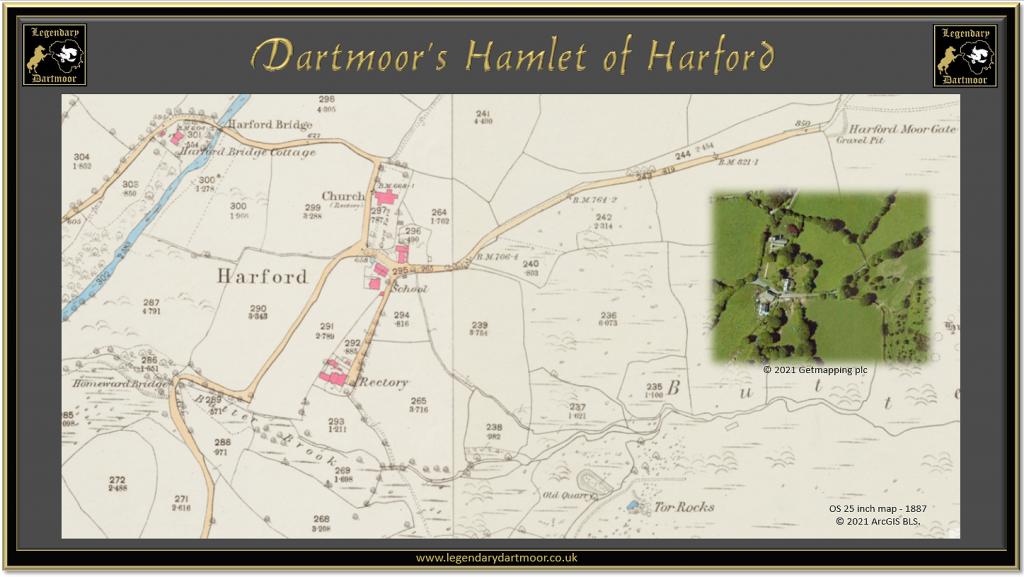
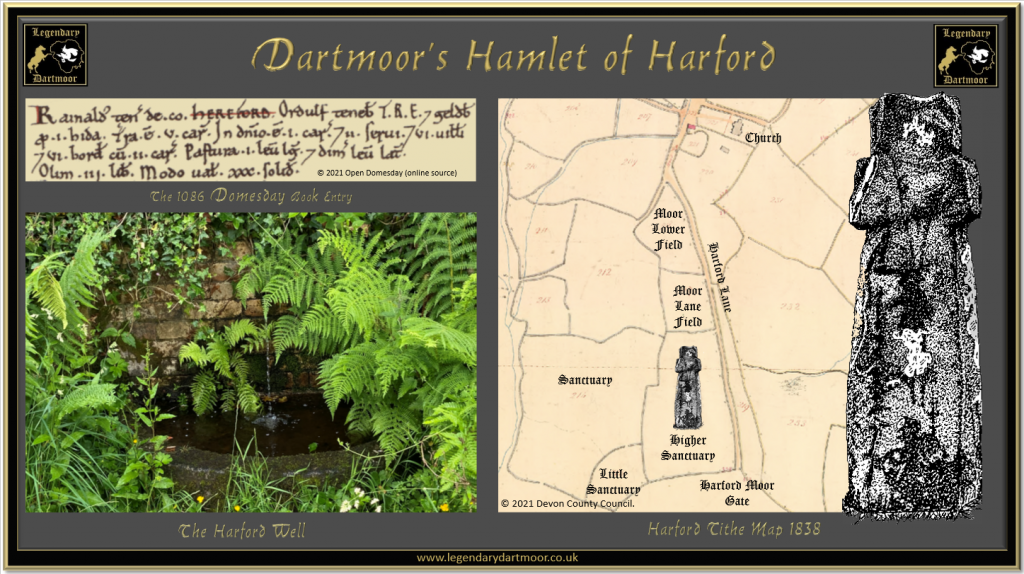
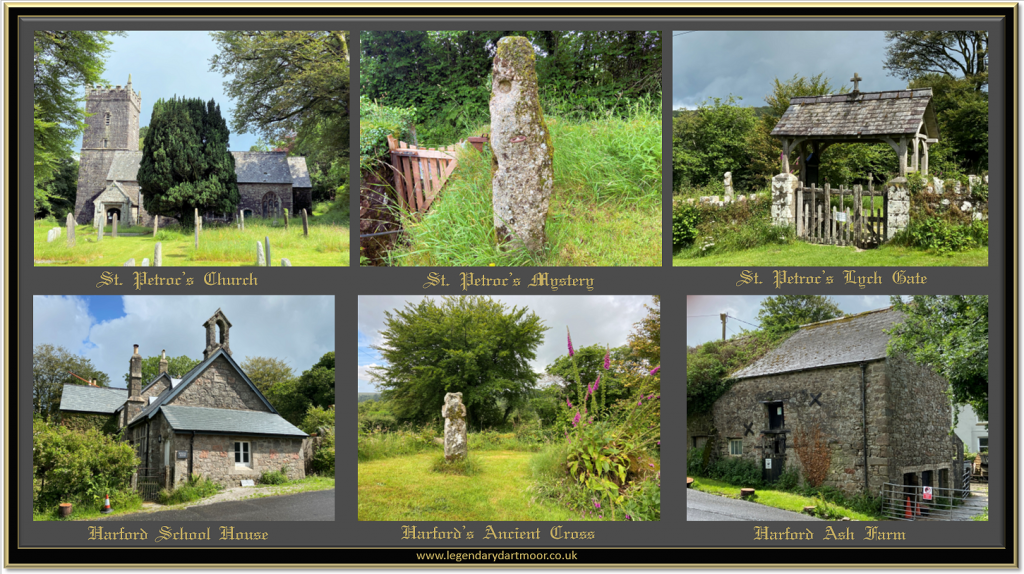
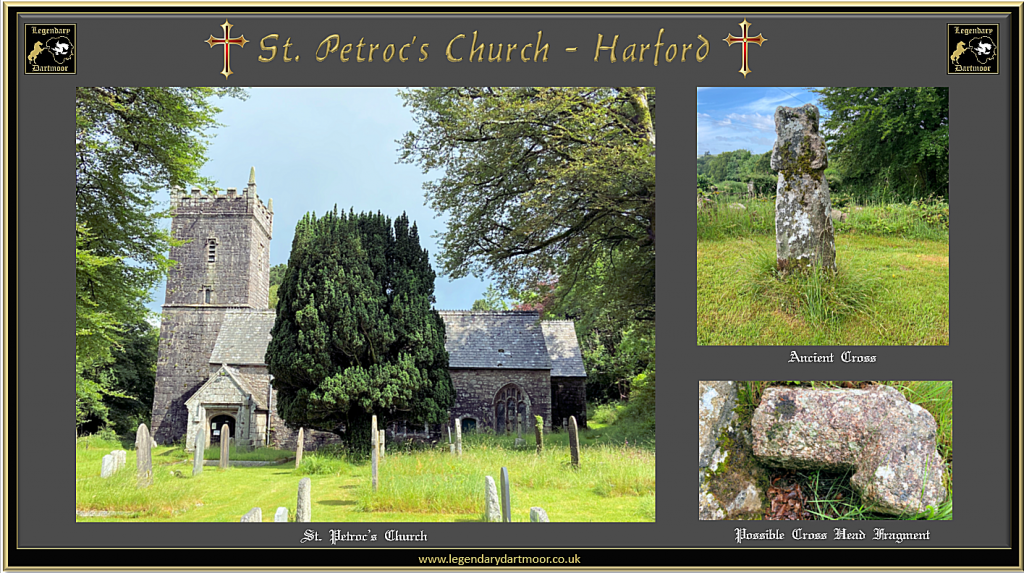
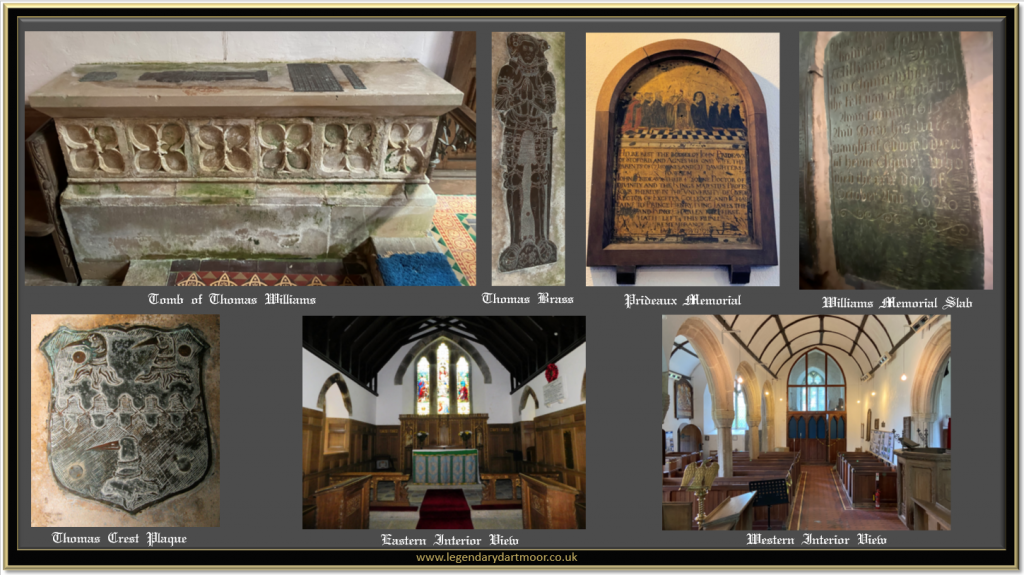
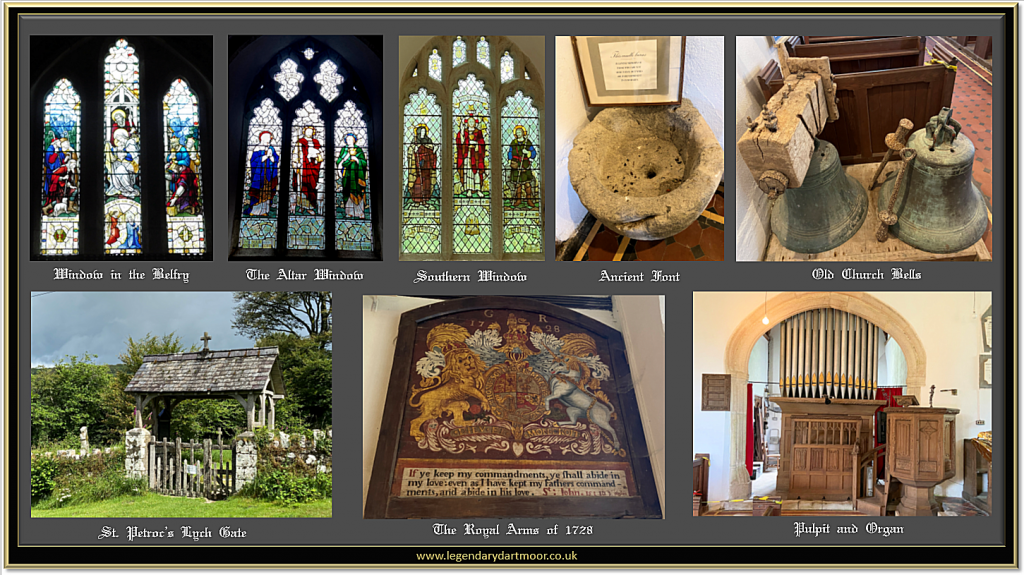
I really enjoyed reading this Tim, thank you. I lived in Cornwood for several years; you have perfectly captured ‘the peace and timelessness’ of Harford.